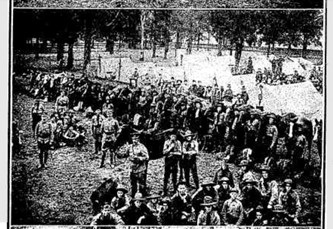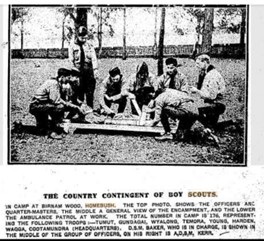Image right: Scout camp at Birnam Wood, Strathfield, the home of John Maclean Arnott, 17 May 1912. Courtesy State Library of NSW
The Boy Scout Movement was founded by Robert Baden-Powell in England in 1907, quickly spreading throughout the British Empire and the rest of the world. Baden-Powell was a Lieutenant-General who had distinguished himself at Mafeking during the Boer War. He returned to Britain a hero in 1899. During his previous service in India, he had become known for his methods of training recruits in scouting skills. After the Boer War he was encouraged to record his methods and wrote a book called ‘Scouting for Boys.’
Australia’s first Scout troops were established in 1908, with the Owls Patrol formed at Strathfield by October that year. These boys spent their time working in Potts Bush, adjacent to Liverpool Road near Strathfield South.[1] By early 1909 other boys were also active in Homebush, spending their Saturdays on drills and signalling work.[2]
In June 1909 the nucleus of a new Strathfield group was established with the encouragement of army chaplain, Colonel and Reverend Herbert Rose of St Anne’s Church of England, and Captain (later Major) John Maclean Arnott of Birnam Wood, Strathfield. During October 1909 local Scouts provided a guard of honour for the Governor’s wife, Lady Chelmsford as she opened the Floral Fete at Llandilo, the home of Sir Philip Lloyd Jones in Strathfield, the fete aiming to raise funds for beds in tuberculosis hospitals.[3] The same month a scout camp was held in the grounds of Birnam Wood.
The Homebush and Strathfield troops spent a December 1909 Saturday perfecting their scoutcraft skills by constructing a boatswain’s chair across a creek and conveying all the Scouts across. They also built a ‘strong and reliable’ rope bridge and practised ambulance work on bicycles.[4]
The Mosman and Homebush troops held a successful combined camp at Thirroul during Easter 1910.[5] The Strathfield troop again went into camp at Birnam Wood during October 1910 where ‘attack and defence, stalking the sentry, boxing, single sticks, general scout games, and rifle practice were entered into.’[6]
A display of field work was held at Major Arnott’s estate in Strathfield on 28-29 January 1911 when the public were invited to attend. Scouts were required to ‘bring two days’ rations, blankets, coats and tomahawks.’[7]
Shockingly, in December 1911 local Scouts were fired upon in Pott’s Bush while practising bush skills. Three youths with pea rifles were later arrested after a bullet passed through the rim of one Scout’s slouch hat. That same month, 16 Scouts from Cootamundra went into camp at Birnam Wood, the boys enjoying a rare visit to the city. They were taken on excursions throughout Sydney and well-entertained. They also survived an ‘attack’ on their camp by the Strathfield troop.[8] Simulated attacks between troops was a common activity and competition was fierce. It would be interesting to know how many Scouts went on to join the AIF during World War I.
On 24 February 1912 the Burwood, Strathfield and Enfield troops visited Potts Bush for the purpose of hut-building, swimming and skirmishing.[9]

Despatch riders from Cootamundra. Sunday Times 26 May 1912

Baden-Powell visiting the campsite at Cooks River, 18 May 1912. Daily Telegraph 20 May 1912 p.11
But the most exciting event of all was the visit of Chief Scout, Robert Baden-Powell to Sydney during May 1912. On the weekend of 17-18 May, just four years after the Scout Movement commenced, hundreds of Scouts from throughout NSW descended on Strathfield for a camp at Birnam Wood, with another 900 Metropolitan Scouts also encamped further along Cooks River near Wardell Road. Baden-Powell was welcomed there on 18 May along with visitors from all over Sydney. In the lead up to Baden-Powell's visit, a despatch was sent by Governor Chelmsford to be delivered by 29 Cootamundra Scouts to the Chief Scout in Sydney via relay. The despatch ride of 21 relays over 252 miles was undertaken by Scouts, mostly on horseback, from Cootamundra to Sydney with the last changeover of messengers completed on the corner of Homebush and Liverpool Roads, Strathfield South. The Scouts had hoped to complete their ride in 24 hours but the trip took a little longer at 25 hours and 10 minutes. One Scout, fortunately not in possession of the despatch, took a wrong turn on the ride from Colo Vale to Mittagong. ‘Realising his mistake, he persisted in his journey and arrived at Homebush, a distance of 83 miles, next morning, saddle weary, but none the worse for his misadventure, a sterling testimony to his own pluck and to the worth of his mount.’[10] These intrepid, country Scouts then went into camp at Birnam Wood and are possibly among those photographed there on 17 May.



In camp at Birnam Wood. Sunday Times 26 May 1912
Birnam Wood was demolished c.1927 and the estate was subdivided, forming the street, Birnam Grove in its place.[11]

Sydney Mail 23 June 1937 p.48 https://trove.nla.gov.au/newspaper/article/160503827
Scouting groups continued to be active locally for many years. In 1937 the 3rd Strathfield Troop built their own huts, resembling log cabins, behind St Anne's Anglican Church. In January 1939, after a Jamboree near Lindfield, Victorian Scouts were photographed leaving Homebush Station on a special train for their trip home.

Victorian Scouts leaving Homebush Station after the Jamboree near Lindfield, 9 January 1939. Courtesy State Library of NSW
By J.J. MacRitchie
Local Studies Advisor
References
[1] Sunday Times 25 October 1908 p.3 https://trove.nla.gov.au/newspaper/article/126738628
[2] Evening News 26 January 1909 p.3 https://trove.nla.gov.au/newspaper/article/113353253
[3] The Sydney Mail and New South Wales Advertiser 27 October 1909 p.27 https://trove.nla.gov.au/newspaper/article/165737354
[5] Sunday Times 10 April 1910 p.15 https://trove.nla.gov.au/newspaper/article/123836233
[6] Sunday Times 9 October 1910 p.17 https://trove.nla.gov.au/newspaper/article/123832472
[7] Sunday Times 15 January 1911 p.17 https://trove.nla.gov.au/newspaper/article/120784848
[8] Sunday Times 31 December 1911 p.26 https://trove.nla.gov.au/newspaper/article/120690618
[9] Sunday Times 10 March 1912 p.17 https://trove.nla.gov.au/newspaper/article/126052619
[10] Sunday Times 26 May 1912 p.26 https://trove.nla.gov.au/newspaper/page/13506891